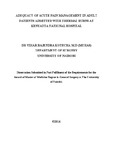Adequacy of Acute Pain Management in Adult Patients Admitted With Thermal Burns at Kenyatta National Hospital
Abstract
Background:
Worldwide incidence of adult thermal burns is 3-10%. Thermal burns cause significant tissue
injury leading to acute pain which if not adequately controlled leads to delayed wound
healing, prolonged hospital stay and psychological disturbances like depression and
posttraumatic stress disorder. There is paucity of literature concerning burn pain assessment
and adequacy of its control in our setup. This study aimed to assess the adequacy of pain
control in adult patients with thermal burns admitted to KNH.
Methods:
A descriptive study with a sample size of 138 adult patients admitted to KNH due to thermal
burns were recruited for this study. Study duration was six months from February to July
2015. The data collected was demographic data, aetiology of burns, pain scores using Visual
Analogue Scale, degree of burn and mode and type of analgesics offered. Data was analysed
using STATA v.11.2, frequencies, means, medians were used to describe data. Student’s ttest
& chi-square were used to test for statistical significance with p-value of < 0.05 showing
statistical association.
Results:
Median age of the study population was 28 (IQR 22-38), majority were males 65%. Sixtyfive
percent sustained moderate to major burns. Etiologies were mainly flame and scald each
contributing 35% respectively. Pain assessment was not done in majority at A&E and wards
98% & 95% respectively. The correlation between TBSA and intensity of pain and degree of
burn and intensity of pain was not statistically significant. Pain control at KNH was found to
be inadequate with only 17% having adequate background control of pain and 7% having
adequate procedural pain control. There was judicious use of analgesics at A&E (96%) but
this not a common practice during change of dressing (29%). Mostly the mode of offering
analgesia was unimodal 77% at A&E and during dressing. The choice of analgesics was
opioids in both places.
Conclusion:
Pain assessment is not a common practice at KNH hence its management was very arbitrary.
Pain control is inadequate amongst patients with thermal burns at KNH. These findings are
contrary to the recommendation from other burn centres. Judicious use of analgesics is
recommended to control procedural pain, but at KNH only 26% of the patients received
analgesics during change of dressing yet the VAS scores remained at moderate pain to severe
pain despite the use of procedural analgesics.
Publisher
University of Nairobi
Subject
Acute Pain ManagementRights
Attribution-NonCommercial-NoDerivs 3.0 United StatesUsage Rights
http://creativecommons.org/licenses/by-nc-nd/3.0/us/Collections
The following license files are associated with this item:


